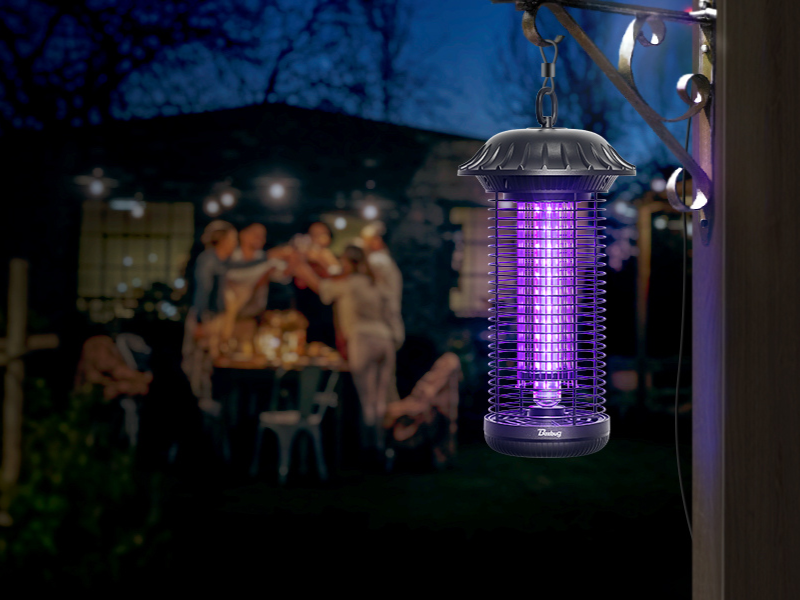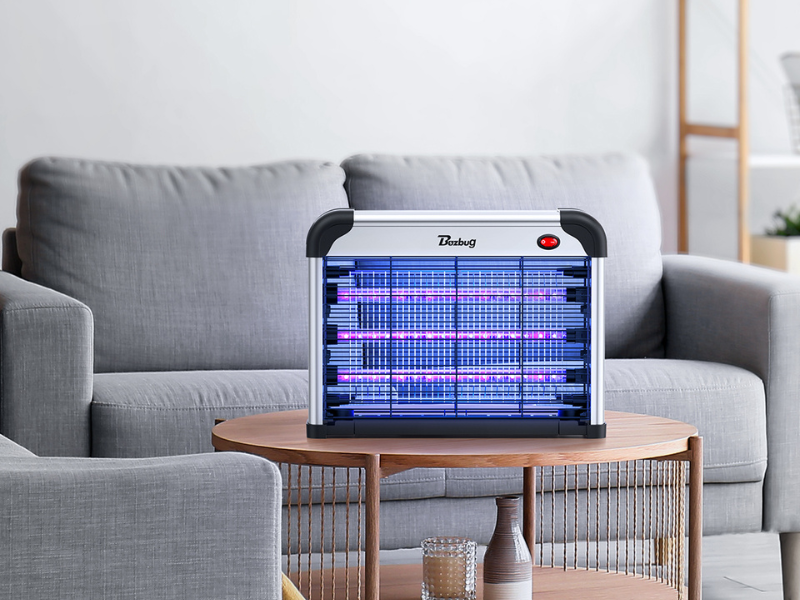Bug zappers are a fantastic way to enjoy your outdoor space without constantly swatting at mosquitoes. But, like any tool, they work best when used correctly. There are a few common mistakes people make that can reduce a bug zapper’s effectiveness—or even make things worse!
1. Placing Your Zapper Too Close to You
1.1 Why Too Close Is Too Much
One of the biggest mistakes people make with bug zappers is putting them too close to where they’re sitting or dining. It might seem like a good idea to have the zapper right next to you—after all, you want to make sure the mosquitoes stay away. But placing it too close can actually backfire.
Bug zappers emit light and heat are bug magnets, but when the zapper is too close, those bugs will be attracted by the heat and carbon dioxide by people, and buzz toward you first before they meet their zappy end.
1.2 Zapper Placement 3 Tips
Place the mosquito killer 15-20 feet away. A general rule of thumb is to keep the zapper at least 15-20 feet away from where you’re sitting or hanging out. This distance allows the zapper to do its job while keeping you out of the bug’s flight path.
Keep the zapper at a height of 5-7 feet. This height is perfect for attracting flying insects like mosquitoes and flies, as it’s closer to their natural flight path. Hanging the zapper from a tree branch or mounting it on a post can help you achieve the right height.
Avoid placing the zapper in heavily lit areas. Other bright lights, like patio or garden lights, can compete with the zapper’s UV light, making it less attractive to bugs. Keep the zapper away from competing light sources so it stands out as the main attraction for mosquitoes.
2. Choosing the Wrong Type of Zapper for Your Space
2.1 Size Does Matter: Small Patio vs. Large Backyard
When it comes to bug zappers, size really does matter. Imagine this: you’ve got a tiny zapper buzzing away on your large back deck, but the mosquitoes are still swarming. Or maybe you have a monster-sized zapper dominating your small balcony, blasting bright light into your neighbor’s window. Neither scenario is ideal, right? That’s because the zapper you choose needs to match the size of your outdoor space.
For small spaces like patios, balconies, or even cozy garden corners, a compact zapper is all you need. These smaller models are designed to cover areas of around 200-500 square feet. They’re lightweight, easy to move around, and won’t overpower the space with unnecessary brightness or noise. On the flip side, if you have a big backyard or you’re hosting an outdoor event, you’ll need something with a little more firepower. A larger zapper designed for areas of 1,000 square feet or more will ensure that your space stays bug-free without having to place a dozen smaller units all over the place.
2.2 Indoor Zapper? Outdoor Zapper? Know the Difference
Another common mistake is using the wrong type of zapper for the location. Yes, there are indoor and outdoor bug zappers, and using the wrong one can lead to a disappointing (and buggy) experience. Indoor zappers are usually smaller, quieter, and designed to zap flies, fruit flies, or the occasional mosquito that makes its way inside. They’re typically not powerful enough to handle the swarm of insects that come with being outdoors.
If you’re buying a zapper for your yard, make sure it’s labeled for outdoor use. Outdoor zappers are designed to handle the elements, from rain and wind to the full force of bug invasions. They often have more durable materials, stronger UV lights to attract bugs from farther distances, and are built to withstand harsher conditions.
3. Ignoring Regular Cleaning and Maintenance
3.1 Why Regular Cleaning Makes a Difference
Cleaning your bug zapper isn’t just about aesthetics (although, let’s be real—no one wants a zapper full of bug parts). It’s also about functionality. Regular cleaning ensures that the zapper’s light stays bright and attractive to insects. Moreover, regular cleaning helps keep your zapper running longer. Like any electronic device, your bug zapper needs maintenance to stay in good shape. By clearing away buildup, you’re reducing the strain on the internal components, which can prevent malfunctions and extend the life of your zapper. It’s a simple task that pays off in the long run!
3.2 Clean & Maintenance Tips for Long-Term Performance
To clean your bug zapper, always start by turning it off and unplugging it for safety. If it has a collection tray, remove it, empty the debris, and rinse it before drying. For bugs stuck in the grid, gently brush them away with a soft brush, being careful not to damage the wires. Finally, wipe down the exterior with a damp cloth, avoiding harsh chemicals.
For long-term maintenance, replace the UV bulbs when the light dims, typically after about 3,000 hours of use. However, Buzbug's UV-LED light has an exceptionally long lifespan of about 30,000 hours, so you'll need to maintain the product significantly less often. Store the zapper in a dry, cool place during the off-season, and periodically inspect the power cord and wiring for any signs of wear or damage. These simple steps will help your zapper perform efficiently for years.
4. Relying Only on the Zapper for Pest Control
4.1 Mosquitoes Are Tricky: They’re Attracted to More Than Just Light
One of the biggest challenges with mosquitoes is that they’re crafty little creatures. While zappers do a fantastic job at attracting insects with UV light, mosquitoes aren’t only drawn to the glow. They’re also attracted to the carbon dioxide we exhale, body heat, and even sweat. That’s right—you, my friend, are a walking mosquito magnet! Even with a powerful zapper, you might still find yourself surrounded by a few persistent pests.
4.2 Create a Multi-Layered Defense Against Pests
To get the most out of your zapper, combine it with other pest control methods. For example, reduce standing water around your yard (a mosquito breeding ground), use citronella candles or torches, and consider applying a natural insect repellent to your skin. These additional measures help minimize the mosquito population, making your zapper’s job easier. By using a multi-pronged approach, you’ll enjoy a much more bug-free environment. We will introduce more detailed methods in the next blog to help you create a truly mosquito-free zone.
5. Bonus Tip: Watch Out for Competing Lights
Here’s a little bonus mistake to avoid—using too much lighting near your zapper. While bug zappers are designed to attract insects with their UV light, bright lights from your patio or garden can compete with it, making the zapper less effective. If mosquitoes are more drawn to your floodlights or string lights, they might ignore the zapper altogether.
To avoid this, dim your outdoor lights or keep them at a distance from the zapper. This allows the zapper to shine brightly and attract mosquitoes without any distractions. Your zapper will have fewer competitors for the bugs’ attention, making it more effective at keeping your space clear.
Conclusion
Now that you’re equipped with these simple tips—keeping your zapper at the right distance, choosing the right size, maintaining it regularly, and pairing it with other pest control methods—you’ll be well on your way to enjoying a bug-free yard. Bug zappers are a great tool, but like any tool, they need a little know-how to use them properly. Now that you’re armed with these tips, you’re all set to enjoy a pest-free outdoor experience all season long!


